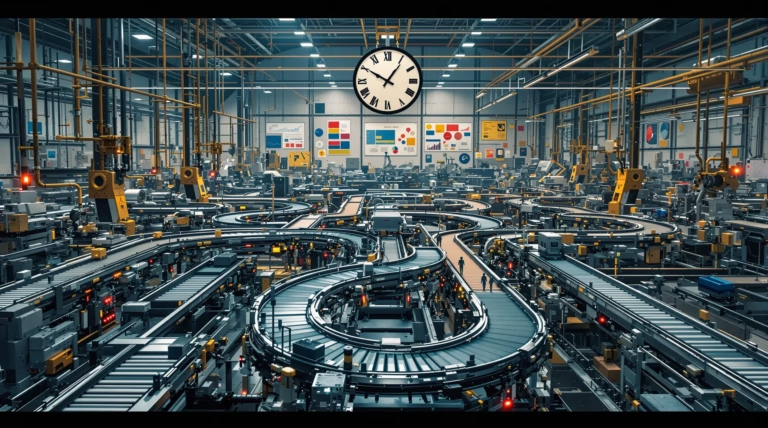Computer-Integrated Manufacturing: Revolutionizing Production Processes
Discover how Computer-Integrated Manufacturing (CIM) is transforming modern production processes through seamless integration of digital technologies. From initial design to final delivery, this comprehensive guide explores the evolution, components, and impact of CIM systems on manufacturing efficiency and innovation.
Understanding Computer-Integrated Manufacturing (CIM)
Computer-Integrated Manufacturing (CIM) represents a revolutionary approach to production that seamlessly integrates various computer technologies and systems to automate and manage the entire manufacturing process. At its core, CIM utilizes a centralized data repository that connects all aspects of manufacturing operations, creating a cohesive ecosystem where information flows freely between different departments and functions.
Unlike traditional manufacturing methods that operate in silos, CIM creates a unified framework where product design, planning, production, and quality control work in harmony through dedicated software packages. This integration enables manufacturers to achieve unprecedented levels of efficiency, flexibility, and product quality while simultaneously reducing production time and costs.
Definition and Components of CIM
CIM represents a holistic approach where all manufacturing functions are integrated through specialized software to ensure seamless data flow across applications. The foundation of this system lies in its ability to maintain continuity between design, engineering, production, and business processes through sophisticated digital infrastructure.
- Hardware Components:
- Computer systems and networks
- Automated material handling equipment
- Robotics and sensors
- CNC machines
- Software Components:
- Computer-Aided Design (CAD)
- Computer-Aided Manufacturing (CAM)
- Computer-Aided Engineering (CAE)
- Computer-Aided Process Planning (CAPP)
- Manufacturing Execution Systems (MES)
- Enterprise Resource Planning (ERP)
- Supply Chain Management (SCM)
Historical Evolution of CIM
| Era | Development |
|---|---|
| 1950s | Introduction of Numerical Control (NC) systems at MIT for aerospace industry |
| 1970s-1980s | Evolution from NC to Computer Numerical Control (CNC); Development of CAD/CAM technologies |
| 1990s | Integration of enterprise-wide systems |
| Present | Implementation of cloud computing, IoT sensors, and artificial intelligence |
Key Technologies in Computer-Integrated Manufacturing
CIM harnesses a diverse set of technologies that collectively transform traditional production processes into highly efficient, automated systems. These technologies form an interconnected ecosystem where information flows seamlessly between different manufacturing stages, enabling rapid response to market demands while maintaining precision and consistency throughout the production cycle.
Role of CAD and CAM in CIM
CAD and CAM systems form the backbone of modern CIM, creating a digital bridge between design concepts and physical production. CAD software enables engineers to create detailed 3D models with precise specifications, allowing for virtual testing and optimization before physical prototyping begins.
- Benefits of CAD/CAM Integration:
- 30% reduction in design-to-production time
- Improved first-pass production quality
- Optimized toolpaths for CNC machines
- Real-time production feedback
- Minimized material waste
Integration of Robotics and Automation
Robotics and automation technologies serve as the physical execution layer in CIM systems, converting digital instructions into precise manufacturing operations. Industrial robots equipped with specialized end effectors perform a wide range of tasks with unmatched consistency and precision.
- Key Robotic Capabilities:
- Material handling and assembly
- Automated welding operations
- Precision painting applications
- Quality inspection processes
- Continuous operation cycles
Advanced CIM implementations feature collaborative robots (cobots) working alongside human operators, creating a synergy between human problem-solving abilities and robotic precision. The automated ecosystem includes Automated Guided Vehicles (AGVs) and sophisticated material handling systems that enable efficient component movement based on real-time production demands.
- Benefits of Automation Integration:
- Enhanced production flexibility for customized manufacturing
- Improved workplace safety through hazard reduction
- Optimized resource utilization
- Reduced production cycle times
- Rapid adaptation to market changes
Benefits of Implementing CIM
Computer-Integrated Manufacturing creates a seamless digital ecosystem that transforms fragmented production activities into a synchronized system. Organizations implementing CIM typically experience:
- Quantifiable Improvements:
- 15-35% increase in productivity
- 10-20% reduction in production costs
- Faster product development cycles
- Enhanced market responsiveness
- Continuous data-driven optimization
Increased Efficiency and Reduced Costs
| Improvement Area | Impact |
|---|---|
| Production Cycle Times | Up to 40% reduction |
| Material Waste | 15-25% reduction |
| Energy Consumption | 10-15% decrease |
| Quality-Related Costs | Up to 30% savings |
Enhanced Product Quality and Consistency
CIM systems establish exceptional quality control through advanced inspection technologies and automated processes. Computer vision, laser measurement, and sensor systems examine products with microscopic precision, ensuring 100% inspection coverage rather than statistical sampling.
- Quality Control Advantages:
- Micron-level defect detection
- 90% reduction in specification deviations
- Standardized production across global facilities
- Consistent process execution
- Reduced quality management costs
Challenges and Limitations of CIM
Computer-Integrated Manufacturing, despite its transformative potential, presents significant challenges that organizations must carefully navigate. Research indicates that approximately 60% of manufacturing technology initiatives experience substantial delays or budget overruns, primarily due to inadequate planning and risk assessment.
- Implementation Challenges:
- Technical infrastructure requirements
- Organizational culture adaptation
- Workforce capability development
- Strategic alignment maintenance
- System integration complexities
High Initial Investment and Integration Complexity
| Investment Component | Impact on Implementation |
|---|---|
| Initial System Cost | $500,000 – $10M+ depending on scale |
| Integration Budget | 40-60% of total implementation costs |
| Facility Modifications | Substantial infrastructure updates required |
| Production Disruption | Temporary output reduction during transition |
Integration complexity presents significant technical challenges, particularly when connecting diverse systems with different data formats and communication protocols. Legacy equipment often requires custom integration solutions, adding both cost and risk to implementation efforts.
Workforce Training and Adaptation
- Training Requirements:
- 80-120 hours of training per employee
- Digital literacy development
- Systems thinking capabilities
- New equipment operation skills
- Troubleshooting competencies
The psychological and cultural transitions required for successful CIM implementation often prove as challenging as technical aspects. Organizations must address employee concerns about job security and skill relevance through transparent communication and clear career development pathways. Successful implementations consistently pair technical deployment with comprehensive change management strategies that address both skill development and cultural transformation.
Case Studies of Successful CIM Implementations
Organizations that have successfully implemented CIM demonstrate significant operational improvements across multiple metrics. These implementations share common characteristics of phased technology integration, clear business alignment, and comprehensive workforce engagement.
- Documented Improvements:
- 30-50% reduction in production cycle times
- 15-25% decrease in operational costs
- 40%+ improvement in quality metrics
- Enhanced competitive positioning
- Sustainable market advantages
Case Studies of Successful CIM Implementations
CIM in the Automotive Industry
The automotive industry leads the way in CIM implementation, utilizing integrated manufacturing technologies to tackle complex challenges. Toyota’s Global Body Line system exemplifies this success through seamless integration of design systems with flexible manufacturing cells.
- Toyota’s Implementation Results:
- Model changeover time reduced from days to hours
- Tooling costs decreased by 50%
- First-time quality rates exceeded 99%
- Multiple vehicle models production on single line
| BMW Spartanburg Facility Metrics | Improvement |
|---|---|
| Productivity Increase | 17% |
| Energy Consumption Reduction | 30% |
| Vehicle Configurations | 10+ million possible combinations |
| Connected Equipment | 4,000+ machines and robots |
CIM in Aerospace and Electronics
Airbus’s A350 XWB program demonstrates the power of CIM in aerospace manufacturing, establishing a digital thread that connects design engineering directly to manufacturing processes.
- Airbus A350 XWB Program Achievements:
- Design revisions reduced by 65%
- Time-to-market accelerated by 14 months
- Complete component traceability
- Enhanced regulatory compliance
- Streamlined certification process
In electronics manufacturing, Foxconn’s implementation of CIM showcases precision at microscopic levels. Their advanced facilities integrate automated inspection systems with robotics, maintaining defect rates below 10 parts per million while enabling flexible production of multiple product variants.
The Role of Data Analytics and IoT in CIM
The integration of IoT and data analytics has revolutionized CIM capabilities, delivering unprecedented operational excellence. Manufacturers implementing IoT-enhanced CIM systems typically achieve:
- Performance Improvements:
- 25-30% increase in operational efficiency
- 15-20% reduction in maintenance costs
- 30-45% faster response to production issues
- 10-15% additional productivity gains
- Real-time visibility across all production aspects
Enhancing CIM with IoT Connectivity
IoT connectivity creates an intelligent manufacturing environment where equipment and systems communicate autonomously. Smart sensors monitor crucial performance metrics, enabling real-time adjustments and predictive maintenance.
- Operational Benefits:
- Inventory buffering reduced by 35%
- Unplanned downtime decreased by 40-50%
- Automated material delivery optimization
- Self-adjusting production parameters
- Proactive maintenance scheduling
Data-Driven Decision Making in Manufacturing
Modern CIM environments generate terabytes of operational data that transform subjective manufacturing decisions into objective, data-backed strategies. Advanced analytics platforms using statistical models and machine learning algorithms reveal hidden patterns in production processes, enabling precise optimization of manufacturing parameters.
- Quantifiable Benefits:
- First-pass yield rates increase of 10-15%
- Quality deviation reduction up to 35%
- New product introduction time reduction by 20-30%
- Higher customer satisfaction through data-informed design
- Virtual process simulation capabilities
Future Trends in Computer-Integrated Manufacturing
The convergence of cloud computing, enhanced cybersecurity, sustainability initiatives, and mass customization technologies is reshaping manufacturing excellence. Industry projections indicate that next-generation CIM implementations will deliver:
| Performance Metric | Expected Improvement |
|---|---|
| Productivity Enhancement | 30-50% |
| Resource Consumption Reduction | Up to 40% |
AI and Machine Learning Integration
AI and machine learning are transforming CIM systems into cognitive production environments, analyzing millions of sensor data points to optimize manufacturing processes. These intelligent systems enable:
- Performance Improvements:
- Unplanned downtime reduction by 35-45%
- Semiconductor yield rate increase of 12-18%
- Predictive maintenance capabilities
- Autonomous process optimization
- Self-learning production systems
Sustainability and Environmental Considerations
Next-generation CIM systems prioritize environmental impact alongside productivity and quality metrics. Advanced implementations deliver significant sustainability benefits:
- Environmental Improvements:
- Energy consumption reduction of 25-35%
- Material waste reduction of 30-45%
- Intelligent energy scheduling optimization
- Closed-loop material tracking
- Real-time environmental impact assessment





